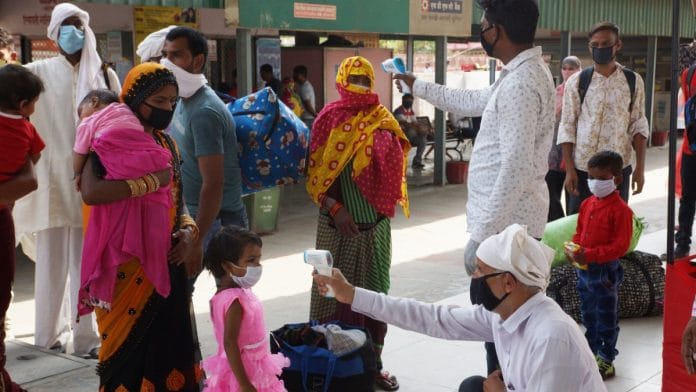New Delhi: The overall Covid-19 reproduction value, denoted as R, for India has been holding steady at 1.22 since 21 May, but the R for Delhi has increased to 1.41, raising some concern.
The R denotes the number of people an infected person can spread the disease to, and is an important indicator of how quickly the infection is spreading.
The national capital, which currently has 19,581 active cases, has been seeing a large number of new cases on a daily basis.
Though both R and the basic reproduction number ‘R0’ (pronounced R naught) denote the number of people one person can infect, the two are different.
On the one hand, R0 is calculated at the beginning of the epidemic when the entire population is assumed to be susceptible to the disease. On the other hand, R changes with time and takes into account that some individuals are protected from the disease, either from having developed the immunity or adhering to preventive measures such as social distancing.
Sitabhra Sinha, a researcher at the Institute of Mathematical Sciences in Chennai, had projected that without lockdown measures, the basic reproduction number (R0) of Covid-19 in India would have been 1.83, which would have translated to 1 lakh active cases by 27 April.
An R of 1.29, as it had been between April 13 to May 14, would have meant that the number of active cases would have hit 1.5 lakh by May 30. Currently, India has 1,37,448 cases.
Between 29 May and 4 June, the R value further reduced to 1.22, from around 1.23 (estimated in the second half of May).
Also read: India’s Covid recoveries continue to outnumber active infections for a second day
Delhi case study
Among states with the highest number of coronavirus cases, several, including Maharashtra, Tamil Nadu and Madhya Pradesh, have shown a decline in the rate of growth of new cases.
In contrast, Delhi’s R value went from 1.2 between 20-25 May to 1.4 between 26 May and 4 June.
The national capital’s R value has been consistently erratic. At the start of May, the R rose to 1.53 from 1.15 (estimated between April 15-18). Subsequently, this value reduced to 1.31 between 7-10 May.
Of the total 32,810 cases reported in Delhi, so far 12,245 cases have recovered and 984 have died.
Also read: Why Delhi’s Covid patients are running from pillar to post in search of a hospital bed
Other states of concern
Haryana, Assam and Uttarakhand have also been a cause for concern given a sudden rise in their R value.
While Haryana’s stands at 1.9, Assam’s R is 1.68 and Uttarakhand’s is 2.07.
Since the numbers of infections have only recently started growing in these states, an R value was not calculated earlier. However, they currently stand at a substantially larger number than many other states.
Uttarakhand has had only 1,562 confirmed coronavirus cases so far, of which 15 have died while 831 people have recovered. The state crossed the 1,000-mark only earlier this month.
Haryana reported 5,579 cases in total while Assam has reported 3,092 cases.
Also read: Ramdev sends Ayurveda medicines to quarantined Uttarakhand CM Rawat, ministers to fight Covid
High performing Maharashtra
Maharashtra has consistently been the state with the most number of coronavirus cases for more than a month now. In fact, its growth curve has been similar to that of India’s overall numbers.
For the period of 13-26 April, the state’s R value was estimated to be 1.49. This dipped to 1.34 between 23 April-15 May, and further to 1.27 by 25 May. Between 30 May and 4 June, the number was pegged at 1.18, lower than India’s R value, Sinha said.
The state currently has 46,086 active cases.
Also read: Maharashtra has highest number of Covid cases in India, but is fifth in terms of fatalities
Decline in other states
Tamil Nadu, the state with the third highest number of active cases, was estimated to have 1.31 R value 30 May and 4 June. After a brief period in early May, when the R value was above 2, the number settled to 1.56 in the first half of the month, Sinha said.
The state, which recorded 17,182 active cases as of Thursday, had seen a spike in the new cases in early May, which was a result of people crowding Chennai’s Koyembedu wholesale market and panic buying, turning it into a hotspot.
West Bengal too showed a marked reduction in its R value to 1.26. Between 15-28 April, the value for the state was 1.51.
After showing rapid growth in cases recently, possibly due to the large scale movement of migrant workers, Bihar, Jharkhand and Jammu & Kashmir have seen their R values settle around 1.4.
Gujarat, Madhya Pradesh and Rajasthan — which were hotspots in the early stages of the pandemic in India — have very low growth rates now.
Of the 21,521 cases that were reported in Gujarat from the beginning, only 5,439 were active as of Thursday.
Both Madhya Pradesh and Rajasthan recorded over 10,000 total cases, but the active cases now stand at a little over 2,700.
Also read: Why these 2 Tamil Nadu towns have made it to India’s 13 cities worst-hit by Covid






